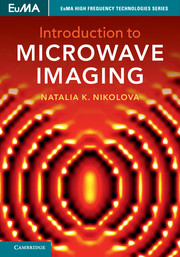Book contents
- Frontmatter
- Dedication
- Epigraph
- Contents
- Preface
- Notation
- Acronyms
- 1 Scalar-Wave Models in Electromagnetic Scattering
- 2 Electromagnetic Scattering: The Vector Model
- 3 Scattering Parameters in Microwave Imaging
- 4 Linear Inversion in Real Space
- 5 Linear Inversion in Fourier Space
- 6 Performance Metrics in Imaging
- 7 Looking Forward: Nonlinear Reconstruction
- Appendix A Maxwell's Equations
- Appendix B Electromagnetic Vector Wave and Helmholtz Equations
- Appendix C Scalarized Electromagnetic Models
- Appendix D Causal, Acausal, and Adjoint Solutions to the Wave Equation
- References
- Index
6 - Performance Metrics in Imaging
Published online by Cambridge University Press: 08 July 2017
- Frontmatter
- Dedication
- Epigraph
- Contents
- Preface
- Notation
- Acronyms
- 1 Scalar-Wave Models in Electromagnetic Scattering
- 2 Electromagnetic Scattering: The Vector Model
- 3 Scattering Parameters in Microwave Imaging
- 4 Linear Inversion in Real Space
- 5 Linear Inversion in Fourier Space
- 6 Performance Metrics in Imaging
- 7 Looking Forward: Nonlinear Reconstruction
- Appendix A Maxwell's Equations
- Appendix B Electromagnetic Vector Wave and Helmholtz Equations
- Appendix C Scalarized Electromagnetic Models
- Appendix D Causal, Acausal, and Adjoint Solutions to the Wave Equation
- References
- Index
Summary
There are several basic metrics used to evaluate the performance of a MWimaging system. They share similar definitions and methods of evaluation with the optical, acoustic, magnetic-resonance, or X-ray imaging systems. These metrics can be divided into two groups: (i) those that measure the quality of the raw data produced by the acquisition hardware and (ii) those that measure the quality of the final images.
The choice of metrics used to evaluate the quality of the final images is dependent on whether the images are qualitative or quantitative. The accuracy of the quantitative images is usually evaluated with the relative root-mean-square error (RRMSE), which we already used in some examples; see Eq. (4.98). This approach requires an experiment with an object, the permittivity distribution of which is known exactly. The evaluation of the accuracy of a qualitative image is somewhat subjective because it depends on how the image is displayed and interpreted. This is why, in medical imaging, various metrics have been introduced such as the signal-to-noise ratio of an ideal observer (SNRI), the image contrast resolution, the spectrum of the noise equivalent quanta (NEQ), the SNR of the decision statistics, the detective quantum efficiency, and others; see, e.g., [238, 239, 240]. They are studied in relation to the clinical specificity and sensitivity of an imaging method. These metrics are not common in MW imaging and they are beyond the scope of this text.
Here, we focus on the first group of metrics since they are independent of the reconstruction approach used to process the data. The most common metrics related to the performance of the hardware are: (i) the best achievable spatial resolution, where indicates the direction in which the resolution is assessed, (ii) the data signal-to-noise ratio SNRd, (iii) the data dynamic range D d, and (iv) the physical contrast sensitivity.
We start with the spatial resolution, which dictates the choice of the frequency and the bandwidth of the system. Moreover, it plays a role in the design of the acquisition surfaces and the mutual placement of the transmitting (Tx) and the receiving (Rx) antennas. It should be noted that the spatial resolution of an image is also dependent on the specifics of the reconstruction algorithm and whether evanescent-field information is available in the acquired data.
Information
- Type
- Chapter
- Information
- Introduction to Microwave Imaging , pp. 266 - 289Publisher: Cambridge University PressPrint publication year: 2017
